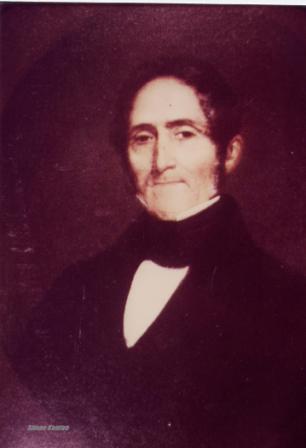
Yeoman Family Tree Connection to Simon Kenton

Simon Kenton
Simon Kenton was a famous frontiersman, the subject of many books and articles. He was Marcus Lee Yeomanís (Ruth Yeomanís father) great, great, great grandfather on his motherís (Margaret Parkison) side. The Kentonís can be traced back to John Kenton who immigrated to the United States.
John Kenton
John Kenton (or Kinton) was born in 1675 in Lycarus County Down, Ireland. The name of his spouse is unknown. Tradition tells of triplets being born to a family by the name of Kenton in Ireland on March 1, 1701. It was probably that the fatherís name was John Kenton
(John Kinton). Although the name is of English origin, the family is listed as being in Ireland as early as the sixteenth century. We know the names of only two of the triplets, Mark and Thomas. They came to America at an early age. One story tells of Mark being kidnapped and brought to Virginia to be sold to pay for passage money. Regardless of how these two came to America, they found relatives living in the Philadelphia area when they arrived. A Mark Kenton was one of the first lot ownerís of that city, and another, Thomas Kenton, was living in Oxford Township in Philadelphia County. Mark eventually settled in Virginia and became the father of Simon Kenton, who won fame as an Indian fighter and a pioneer in Kentucky.
Thomas Kenton lived for a time in Germantown, PA with relatives. We have no record of his early life, but as of 1737, he was trading with the Indians on the Ohio and was one of that intrepid band of frontiersman who carried blankets, ammunition, trinkets and probably rum to the Indians in exchange for peltry furs. His first purchase of land was in that area where other Irish and Scotch-Irish had settled and was, at that time, the farthest frontier in Pennsylvania. These people, fleeing from religious persecution first in Scotland, then in Ireland were not welcomed by the Germans who had settled in fertile southern tier of the counties in Pennsylvania. They quickly passed through Chester and Lancaster counties, the west bank of the Susquehanna River, settling along the Pennsylvania Maryland border. They have been described as ďchampions of civil and religious liberty, cool, calculating, practical and hardheadedĒ a type not calculated to adjust well with the German population but definitely the kind of people to open up the wilderness of the frontier. Trade with the Indians of the Ohio Valley was the opening wedge and also a profitable venture.
Mark Kenton
Mark was born March 1, 1701 in County Down, Ireland. In exchange for his passage to the colony, he indentured himself to a Virginia landowner for five years. He became a tenant farmer, under the Carter Grant, near the area of Hopewell Gap, (not Hopewell, Virginia) where among other crops, he raised tobacco. Mark and Mary Miller Kenton reared their family there in the foothills of the Bull Run Mountains, Prince William County. In 1759, the county separated to become Fauquier County. Children of Mark and Mary were William, Polly, Mary, Jane, Frances, Mark Jr., Benjamin, Simon, John, and Nancy. Mark died October 16, 1783 while on the journey to Kentucky. He was buried at the mouth of Peterís Creek, near New Store (present day Elizabeth, PA) His wife, Mary, lived with her son John, in Washington, Mason Co., Kentucky, until her death December 12, 1807.
Preface from Denise Moore's "An accounting of some of the descendents of
Mark Kenton & Mary Miller"...
MARK KENTON OF BULL RUN MOUNTAIN, VIRGINIA
The year was 1718 when the young men of eighteen and thirty years
disembarked from the ship in an unknown port in the wilderness of Virginia/ The
ship, also, has remained anonymous which brought the progenitors of the Kenton
family across the ocean from the Emerald Isle. Theirs had been a long and weary
journey, filled with days of endless sea and the continued pitch and roll of the
small ship. With the best of weather conditions the crossing would have taken
several months. Supplies were stored aboard ship for the nourishment of the
travelers and crew, using the mean average of the general time of the journey.
The ship was propelled on to its destination at the mercy of the winds. If a
ship was becalmed many days the supplies were quickly depleted. Thus, many ocean
crossings found their travelers starving and sickly when they finally reached
land. The food stored within the hold of the ships was neither an adequate nor a
balanced diet. They had no means of refrigeration and the only way to hold food
for long periods of time was drying or storage in brine. Fresh fruits and
vegetables which had been put aboard were quickly used before they would spoil.
Many ocean travelers suffered from scurvy, which was caused by a lack of Vitamin
C; derived from fresh foods.
Before modern technology, there was no way to predict hurricanes.
Ships generally stayed in port during the season of the storms and when they had
to venture out would do so with the utmost trust in God to give them a safe
crossing. Today, we give the hurricane season from June through November. Our
ancestors were not so generous in giving the hurricanes as much time, and
because of this practice, many ships were lost to the storms.
Upon landing the brothers found that the new life that they had to
create for themselves was not much easier than the ocean crossing. In many
instances, the wilderness of this new land gave more heartaches than the many
months of endless sea. As the young only see ahead, they were determined to make
the land bend beneath their wills, and we find that neither brother returned to
the land of their birth.
The brothers were to part company soon after their arrival. Thomas
was to wander to the settlements of the north and marry a young lady of the
Boston area, Rebecca Stoves. A year later a son was born to this couple, Thomas
Kenton, Jr. Thomas Kenton, Sr. possessed the trait of curiosity of the two
brothers; becoming an Indian trader and exploring the wild and unspoiled land in
conjunction with his business.
The paths of Thomas and Mark Kenton were to cross seldom after their
arrival; only after long intervals would the travels of Thomas unite the two.
Because Mark was tied to the land, having chosen farming as his occupation, he
was unable to travel and visit with his relatives. At this point in time, the
family of Thomas Kenton escapes recording. Circumstantial evidence of Kentonís
in the area of Fauquier County, Virginia and later in Mason and Mercer Counties
of Kentucky lead this writer to believe that perhaps Thomas Kenton, in his later
years, or perhaps his descendents did, in fact, keep close ties with the family
of Mark Kenton.
Mark Kenton was born 1 March 1701 in County Down, Ireland. In
exchange for his passage to the colony, he indentured himself to a Virginia
landowner. With the experience gained during this indenture, Mark became a
tenant farmer after the term of five years servitude. Mark labored as a farmer
under the Carter Grant near the community of Hopewell, Virginia, where, among
other crops, he raised tobacco. Mark reared his family at Bull Run Mountain;
here they would remain until enticed to the new lands of Kentucky in 1783.
In January of 1737, Mark Kenton was married to Mary Miller, a lady
of 23 years, born of a Scotch-Welsh family that had settled in Virginia at an
early day. Mary Miller Kenton was born in 1714 in Virginia and died on 12
December 1807 in Washington, Mason County, Kentucky where she was residing in
the home of her son, John Kenton.
Mark Kenton died on 16 October 1783 while on the journey which would
relocate the family in Kentucky. He was buried at the mouth of Peter's Creek,
near New Store (the present day Elizabeth) Pennsylvania. Mark Kenton and Mary
Miller reared a family of nine children, several of whom made the trek to the
wilderness of Kentucky. The fourth son, Simon, left home at an early age
and earned the reputation of a frontiersman and scout. This son, after exploring
the frontier, returned home in 1783 and convinced various members of his family
to relocate in the area of Salt Lick. Mention of Kenton family members, or their
relatives, in the records of Virginia are nearly non-existent; however, several
of the names were listed as having paid debts owed to the estate of Mary Bland
in 1782-1783: Mark Kenton, Sr. William Owens, William Kenton, John Willoughby,
Cornelius Rains, Johnson Owens, Thomas Laws
Money, for an undetermined reason, was also paid to: John Owens
(Abstracts of Fauquier County, Virginia, Wills, Inventories and Accounts
1759-1800 by John KJ. Gott, 1972 - (Page 155) - Mary Bland (Administrators
Account) Returned 28 Sept 1784)
There have been several lists of the party which left Fauquier
County, Virginia bound for Kentucky on 16 September 1783. The lists vary
slightly, but, it appears that there were at least 23 members of the Kenton
family to arrive in Kentucky: Mrs. Mark Kenton (Mary Miller), Nancy Kenton and a
child, William Kenton and wife Mary, with six of their children, Thomas Laws and
wife Jane Kenton with four of the Owens sons, and three of the Owens daughters
by Jane's first marriage, and two of the Laws daughters, Simon Kenton.
In addition, the following persons also traveled to the frontier: A
negro woman and child with Mrs. Mark Kenton, a negro girl with William Kenton
and family, Elijah Berry, wife, two children and a negro man, James Whitehouse,
wife and three children, John Metcalf (father of Governor Metcalf), John
Griffith, a negro woman with Simon Kenton, John McGraw and wife.
The party attempted to land at (Simon) Kenton's station in the area
of Salt River, however, seeing signs of Indians they moved on to Limestone. Here
the party split, some returning to Salt Lick and others moving down to the Falls
and later to Quick's Run. In the forest area of Mercer County several members of
the family remained a number of years.
Over the next few years other members of the Kenton family moved
form the lands of Virginia into Kentucky. By 1 October 1784, Thomas Dowden's
widow, Sally Cleland (sister of Mary Cleland Kenton) and her four children
settled in Kentucky. By 1785 the Edward brothers, along with their sister, Jane,
and her husband William Rains, had arrived. Also, William McGinnis, who was
killed by the Indians in November of 1786, had settled in Kentucky by 1785.
A petition, to form Washington in Mason County, was drawn up on 22
August 1786 and signed by, among with others, by the following: John Kenton,
John Rains, Simon Kenton, William Rains, William McGinnis, James Rains,
Cornelius Rains.
A petition, asking for a division of Bourbon County, was signed on
19 September 1787. The state of Virginia was again petitioned for a third time
in 1787 asking for the division of Bourbon County. Among others, both petitions
were endorsed by the following:
John Kenton, Simon Kenton, Cornelius Rains, John Rains, William Rains.
The name of Thomas Kenton (son of William Kenton and Mary Cleland)
was found on a petition signed in the summer of 1790 (endorsed 1 November 1790)
for the formation of Maysville in Bourbon County.
All of the descendents of Mark Kenton and Mary Miller eventually
left Virginia and the majority of them moved into the Kentucky area before
migrating to other western states.
∑ ID: I0146
∑ Name: Simon Kenton
∑ Sex: M
∑ Birth: 3 APR 1755 in Hopewell Gap, Prince William, Fauquier County, Virginia
∑ Death: 29 APR 1836 in Bellefontaine, Logan County, Ohio
∑ FA1: Associate of Daniel Boone
∑ Burial: Oakdale Cemetery, Urbana, Ohio
∑ Note: Buried in Logan County,
later moved to Oakdale Cemetery, Urbana, Champaign County, Ohio. A monument,
designed by John Quincy Adams Ward, was erected. It was completed, with the
addition of the statue Ward originally intended, in 1997.
Simon Kenton was known as a frontiersman and scout. To learn more of
his accomplishments: The Frontiersman by Allan W. Ekert, Little Brown,
Sept 1967, reprinted by Bantam; The First American Frontier, reprinted
1971, Advisory Editor; Simon Kenton, His Life and Period, 1755-1836 by
Edna Kenton, 1930. The Draper Papers, BB Series is a collection of letters
written by the descendents and acquaintances of Simon Kenton. Lyman Copeland
Draper began his collection in 1838 and continued until his death in 1891. Dr.
Draper's primary concern was to preserve the facts of the events of the early
times of this country.
Simon Kenton was married twice. Previous to his marriage he had a
child born out of wedlock by Ruth ... Ruth was later married to Vincent Calvin
in Kentucky.
Simon's first marriage was celebrated on 15 February 1787 in Mason
County, Kentucky to Martha Dowden. Martha was severely burned in a fire while
she was lying in bed awaiting the birth of a child. After being rescued from the
fire, she gave birth to a stillborn child and soon after she also died.
Simon's second wedding was on 27 March 1798 in Mason County,
Kentucky to Elizabeth Jarboe.
Thomas Cleland married Jane Smith. They had two daughters. Sally
Cleland married Thomas Dowden. Their daughter was Martha Dowden, Simon's first
wife. Elizabeth Cleland married Stephen Jarboe. Their daughter was Elizabeth
Jarboe, Simon's second wife.

Simon Kenton 1836 age 81
Simon Kenton was a legendary frontiersman in Ohio and the Midwest. Kenton was born on April 3, 1755, in Fauquier County, Virginia. He grew up helping his father on the family farm and therefore had little opportunity to go to school. At the age of sixteen, Kenton became involved in a fight involving a woman. Believing he had killed a man, he fled to the Ohio Country where he changed his name to Simon Butler.
Kenton spent the next two years hunting along the Ohio River. In 1774, he served as a scout during Lord Dunmore's War. By 1775, Kenton had moved to Boonesborough, Kentucky. For the next few years, he worked as a scout for the settlement, often coming in contact with the local Indians and at one point saving the life of Daniel Boone.
During the American Revolution, Kenton participated in a number of military engagements against the British and Indians. In 1778, he joined George Rogers Clark on a difficult but successful expedition into the Illinois Country, to attack British outposts as well as Indian settlements. Returning home, he accompanied Daniel Boone in an attack on the Shawnee Indians' settlement of Chillicothe near what is now Oldtown, Ohio. That same year, Kenton was captured by Indians who tortured him and attempted to burn him at the stake. Simon Girty rescued him and, instead of being killed, Kenton was sent to Fort Detroit as part of a prisoner trade with the British. By mid-1779, Kenton was free and had returned to service under George Rogers Clark. In 1782, he discovered that the man that he thought he had killed had actually lived. Therefore, he was able to resume his own name once again.
During the next several years, Kenton lived a relatively quiet life. He settled near Maysville, Kentucky, married Martha Dowden and purchased some large tracts of land. Simon married Martha in February 15, 1787. They had five children: Nancy, John, Simon, Sarah, Stillborn child. The stillborn child was lost after Martha gave birth during a fire. This life continued until 1794, when Kenton served in the militia under General Anthony Wayne and fought at the Battle of Fallen Timbers. After the death of his wife, Martha, Kenton remarried in 1798 and, the same year, moved to Ohio. Simon married Elizabeth Jarboe on March 27, 1798. Their children were Matilda Belle, Elizabeth, Mary, William Miller, Elizabeth, Ruth Jane. Somewhere in between marriages Simon had a child by Ruth named Simon Ruth. It is unclear if they were married. He first lived near present-day Springfield but a few years later settled in Urbana. By 1805, Kenton had become a brigadier general in the Ohio militia. During the War of 1812, he participated in the Battle of the Thames in Canada.
Kenton moved to the Zanesfield, Ohio area around 1820. During the last years of his life, Kenton lived in poverty because of land ownership disputes and mismanagement of his money. He survived on a government pension of twenty dollars a month. In 1836, Kenton died in Logan County near Zanesfield and was buried there. In 1865, his remains were moved to Urbana. The state of Ohio constructed a monument to mark his grave in 1884.
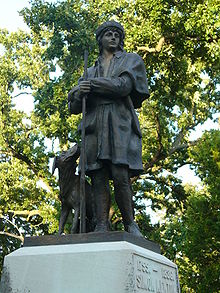
Grave of Simon Kenton, spy, frontiersman, and militia commander.
The grave and monument is in Urbana, Champaign County, Ohio.
The photograph was taken ca. 1940-1949.
Matilda Belle Kenton
Matilda Belle Kenton was born January 23, 1799 in Cincinnati, Hamilton County Ohio. She was the daughter of Simon Kenton and Elizabeth Jarboe. Elizabeth was Simonís second wife. Matilda married John Graham Parkison July 17, 1817 in Kentucky. In the Register of Veterans buried in Jasper County there is listed a John Graham Parkison. Children of Matilda Belle Kenton and John Graham Parkison were Addison, Juliett, William, Joseph Vance, Emma, Mary Jane, Benjamin, Isabel, Martha, Elizabeth, Margaret, and Frank.
Joseph Vance Parkison
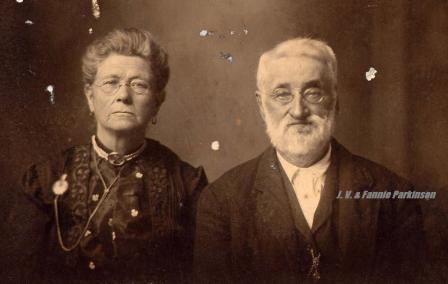
Fannie Kenton Parkison & Joseph Vance Parkison
Joseph Vance Parkison was the son of Matilda Belle Kenton and John Graham Parkison. He was born May 16, 1829 in Ohio. He married Fannie Kenton, his cousin, in 1851 in Jasper County, Indiana. Fannieís great grandfather was William Kenton brother to Simon Kenton. Children of Joseph Vance Parkison and Fannie Kenton were Matilda, William, Eveline, Amanda, Josephine, Margaret, and Jaley.
Margaret (Maggie) Parkison Yeoman
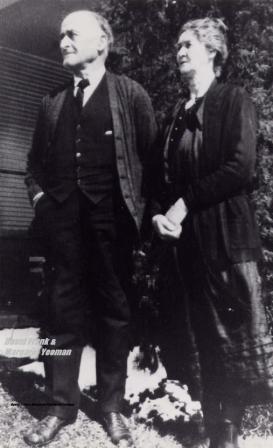
David Frank Yeoman and Margaret (Maggie) Parkison Yeoman
Margaret Parkison was the daughter of Joseph Vance Parkison and Fannie Kenton. She was born April 9, 1864. She married David Frank Yeoman February 6, 1883 in Rensselaer, Indiana. They moved to Colorado first but came back to Kansas. David rode in the opening of the Cherokee Strip in the Oklahoma Land Rush. They moved to Oklahoma and homesteaded. David also ran a hardware store. The children of David Frank Yeoman and Margaret Parkison were Marcus Lee, Mabel Leon (Deon), Hazel Fanny, Amy May, and Joseph Boyd.
Marcus Lee Yeoman
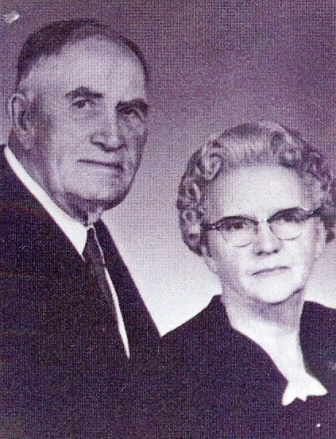
Marcus Lee Yeoman and Gladys Krebs Yeoman are the parents of Ruth Yeoman.
See Yeoman family tree from the beginning.